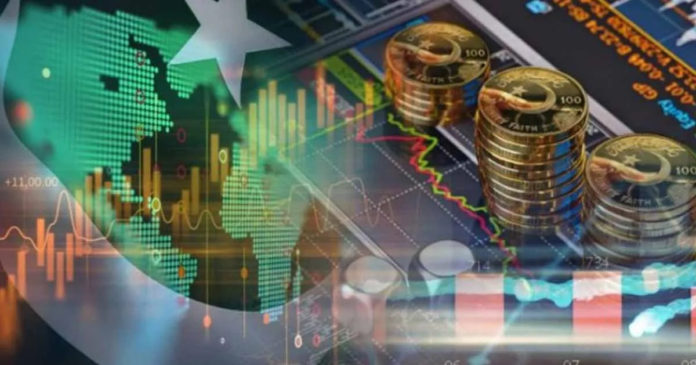One can perhaps say that history loses its significance in the absence of human diligence and that it is more the reflection of a human mind than the corporeal existence of life. The stages of history were actually the evolution of the human mind on this ever contracting earth with increase in its populations and their necessities, though in individual form.
“History after all is summing up, it is the interpreted record of particular event fashioned by observers who may not be intimate with their subject, who may not be participants in the life experience they describe, who may or may not be able to distance them from the story they choose to tell.”1
Pakistan came into being on Muhammad Ali Jinnah’s (founder of Pakistan) vision of the Two Nation Theory2 and the ideology of being a Fundamental Moderate Muslim state. As a matter of fact, Pakistan is no different from the historical process of human mind and the leadership that has ruled over this country in last 69 years. Unfortunately, out of 69 years more than 34 were under direct or indirect military rule, with the military leadership still having an influential role in the State. In the name of the ‘Doctrine of Necessity’ military coups took place, though on several occasions the military leadership was invited by the civilians as a last resort to save the country from collapse. In the following paragraphs we will be discussing the recent economic and political implications of misrule and mistrust amongst the bureaucracy, politicians and the military that has placed Pakistan on a virtual economical and political collapse. Our area of study would be the circumstances post 9/11 attacks on the United States and its consequential aftermath on Pakistan being a front runner state in the Global War on Terror (GWOT).
Economy
“War on terror and Pakistan Army’s stepped up operation on the ever widening front has cost Pakistan over 2.1 trillion rupees with loss of 260 billion in 2005, 301 billion in 2006, 484 billion in 2007, and 678 billion in 2008.”3
Can we afford to conduct such a huge operation and at what cost? Pakistan from its inception had seen economic and trade imbalances that went through several ups and downs predominantly due to domestic factors affecting the foreign capital influx.4 In this context it is important to go through some basic definitions of trade and commerce. By definition the ‘balance of trade is the relationship between a nation’s imports and exports of goods and services.’ Any disparity in trade implies an equal and opposite disproportion in asset trade. A positive trade balance is known as a trade surplus and consists of exporting more than is imported, whereas, a negative balance is known as a trade deficit or in general terms as ‘trade gap,’ which means that exports are insufficient to pay for imports and a trade surplus is the opposite of it, equivalent to the capital account deficit. Trade deficit risks nation’s economic growth as the current account deficit leads to net selling of worldwide assets.
The policy of liberalization, deregulation and privatization led to ‘cheap’ imports inside Pakistan, not realizing that this compulsion would be counter-productive and would have lethal after-effects; even economies like the US could not sustains its aftermath. It was presumed that liberal trade policies would contain imports and increase local production, though it was practiced vice versa. In 1996-97 the amount of such imports were US $ 3.52 billion, this doubled to US $ 6.183 billion in FY 2006-07. It took new heights in FY 2007-2008 with a staggering figure of US $ 20.75 billion. Due to this, the trade deficit widened to US $ 20.746 billion in 2007-08 from US $ 13.563 billion in FY 2006-07, causing further problems for financial managers and policy makers inside Pakistan.
By end of October 2008, political instability and deepening global financial turmoil drove Pakistan on the brink of bankruptcy. The flight of capital from Pakistan squeezed the country’s foreign reserves to US $ 4.5 billion that was sufficient to pay for only six weeks of imports. The disquieting situation served to drive away donors and due to alleged corruption and financial scandals, countries like China, Saudi Arabia and other friends of Pakistan regretted lending more money and ultimately Pakistan had to take refuge under the umbrella of the International Monetary Fund (IMF) to avoid total collapse. While the IMF timely supported the economy, the financial gap had put the basic commodities on higher prices that further squeezed the public spending and cash flow. High imports coupled with rising oil and food import bills became the core reasons for the account deficit.
Serious energy shortage, massive electricity failures, long spells of load-shedding, oil reserves falling to its lowest ebb are some of the looming risks to Pakistan’s production output and economy. Pakistan’s already weakened production base has been further struck hard by the energy crisis. Around 25 percent of the textile units closed down because of electricity shortage while a sizeable number of units are likely to be closed. As a result, local producers are unable to fulfill the supply and chain demand, therefore, imports are drawn to fill in this commodity fissure. Further lowering of the tariffs as per IMF and WTO requirements led to an increase in imports, and a flooding of consumer goods produced in the developed world. Pakistan’s economy in FY 2007-2008 registered imports worth US $ 40 billion while its exports were around US $ 20 billion (i.e. half of its imports).
Another factor for economic meltdown was the declining trend in agriculture growth that ranged from 1.5 percent to 6.5 percent during last six years thereby threatening food security.5 Pakistan’s economy is primarily agriculture based, therefore, main stay of Pakistan export has been rice, cotton, etc. or other value added products that have served to decrease its foreign trade deficit. But for last few years Pakistan’s performance in agriculture sector has dwindled without any consistency while 2008 is regarded as one of the worst years.6
In the dairy farming sector, for instance, Pakistan produces 4.2 billion liters of milk per year, out of which 600 million liters (amounting Rs.12 billion @ Rs.20 per litter) is wasted. Similarly, 15-20 percent of Pakistan’s fruit products decomposed and perished due to inadequate storage facility and transportation to the markets.
Wheat is an another bad example, the export of wheat on marginal prices and then importing it back on higher prices, makes it difficult for local buyers to re-purchase the same wheat on heavy prices, they are by themselves producing.
Higher consumptions and lower domestic savings evaporate the money available for domestic investment causing problems for inflow of foreign investment. Pakistan is earning less foreign exchange through exports and spends almost double on imports, with the result that there was superfluous trade deficit.
Workers’ Remittances also played an important role in the economic survival of Pakistan. The inflows of worker remittances in the year 2007 reached over US $ 6.45 billion setting a new record in the nation’s history. Pakistan is the world’s 12th largest remittance recipient country. In 2008, workers’ remittances showed an increase of 17.43 percent compared to 2007. From 2007-2008, Pakistan received over US $ 6.45 billion from overseas nationals, crossing last year record of US $ 5.49 billion. This trend also started to decline due to unstable economic situation and possible trends in market economy. According to economic theory and Marshall – Lerner7 condition, devaluation may be a cure for some countries to maintain balance of payments deficit but not for all. The condition itself states that devaluation would improve the current account only if the sum of foreign elasticity of demand for exports and the home country elasticity of demand for imports is greater than unity. If the sum is less than one, the devaluation is likely to lead to a deterioration of the current account.
Furthermore, analysts opine that the constant increase in import bill is putting huge pressures on Pakistan’s forex reserves and fast depleting reserves tend to cause depreciation of Pakistan currency (i.e. Rupee).
The Governments generally have no control over the oil and food prices except for those who are managing or producing it. The demand for oil and other imports are directly linked to GDP and population growth, by this principle reduction in oil imports is proportional to reduction in GDP growth. Factually, no government would be interested in reducing their respective GDP growth which would result in slowing down the country’s economy. Dealing with such serious economic irregularities and balancing the trade deficit is not an easy task and concerted efforts are desired to procure the solutions and further implementation.
Pakistan’s is mainly an agriculture based economy. Accounting for the wastage, backwardness and mismanagement in the agriculture sector, and its impact on negative trade balance ought to be at the top agenda for its restructuring campaign. Pakistan can earn current account by improving production and storage techniques, up gradation of forms to market road network and establishing chains for dairy milk and other perishables can save billions of rupees loss.
Import of edible oil would be controlled by increasing production of oil seed, import of milk powder can be substituted by dairy farming. Improvements in cotton production will enable Pakistan textile industry to operate at optimum capacity for utilizing 16 million bales of cotton and exploit the opportunity being unfilled by the ongoing economic global crisis.
Water is also an important factor for any economy. In particular for Pakistan, most of its land is agriculture based and Pakistan needs plenty of water to balance the land and crops. Neighboring India is building more than 50 dams on the Chenab River, by this they are planning to choke supply of water to Pakistan and turn Pakistan’s fertile and arable lands into deserts. Obviously Pakistan can’t revitalize the agriculture sector without forcing India to respect international law on the flow of rivers and Indus Basin Treaty. India has to realize the dangers and damages Pakistan would encounter due to its unrealistic construction of dams, if the problem is not resolved through international pressure then war could become inevitable.
Pakistan exports rice, furniture, cotton fiber, cement, tiles marble, textile, clothing, leather goods, sports goods, surgical instruments, electrical appliances, software, carpets/rugs and food products. It is a major producer and exporter of cement in Asia and Middle-East, its exporting partners are United States, UAE, UK and China. It is the need of the day to diversify the range of exportable products making Pakistan less dependent on textiles (which currently contribute over 60 percent of total exports) and other routine exports. A serious rehabilitation is required to overcome the problem of bad finished goods being exported to foreign markets.
Michael Porter’s cost leadership strategy is verily a fulcrum of success in global trade. By the time the cost of doing business is not lowered, any commendable effort for increasing exports by reducing the trade deficit would threadbare.
IMF’s conditional credit facility with a specific price tag would push up energy costs and interest rates having challenging consequences in Pakistan’s manufacturing sector. At the same time an anti-industrialization clause encounters problems in the government’s resolve to bring a shift in ‘consumption led to production growth.’
Pakistan’s negative trade balance is a constant problem due to international capital flows. Privatization of national assets on dismally low prices during the period of ongoing recession is a poor choice and the borrowing from the IMF has started showing stresses on the public. Factors affecting the trade deficit are largely of domestic origin that could be fixed or alleviated by the tools of the national budget and trade policy.
Pakistan is a net loser in outcome of Free Trade Agreement (FTAs) as it is facing trade deficit in three FTAs out of total five signed so far with member countries, Sri Lanka, China, Malaysia, Indonesia and Mauritius. With the exception of Sri Lanka and Mauritius, Pakistan has a trade deficit with all the partner countries with which it has signed trade agreements. In the case of Sri Lanka US $ 217 million and Mauritius US $ 21.288 million surplus is not very significant. A study prepared by Pakistan Business Council maintains as follows,8
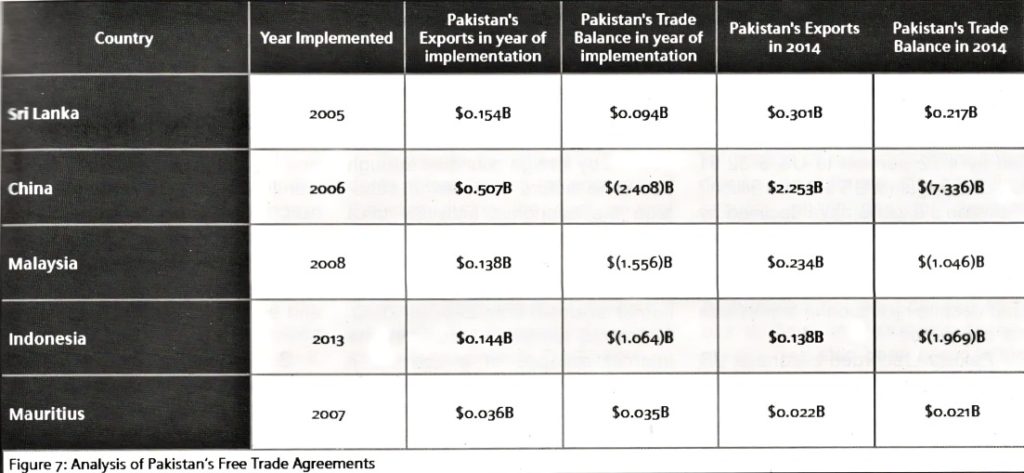
The report suggested that Pakistan’s global imports have been rising steadily since 2003. In 2014 it reaches its peak with US $47 billion. It was further stated that since 2003, Pakistan’s global exports have also been on the increase with international exports in 2014 amounting US $27.4 billion. From 2003-2014, global exports rose by 73 percent, while the total increase in exports were only of 53 percent.
Following the recent trends, Pakistan Bureau of Statistics (PBS) established that Pakistan’s trade deficit has exceeded 20 percent in March 2016 as imports amplified by US $ 3.78 percent despite visible fall down of commodity prices in the international markets. Balance of trade for March 2016 has negative indicators with US $ 1.85 billion as compared to the deficit of US $ 1.53 billion in the corresponding month in 2015. Exports for March 2015 were recorded with decline of 9.55 percent to US $ 1.74 billion as against US $1.92 billion in March 2015. Imports increased to US $ 3.59 billion as compared with US $ 3.46 billion. The trade deficit widened by 5.5 percent to US $ 16.9 billion during July – March 2015/2016 as compared with deficit of US $ 16 billion in the corresponding period of the year 2015. Exports of the country fell by 12.92 percent to US $ 15.6 billion as compared with US $ 17.92 billion. Imports into the country also fell by 4.22 percent to US $ 32.51 billion as against US $ 33.95 billion.9 Pakistan’s exports have declined by 14.37 percent in the first seven months of fiscal year 2015/2016, which further increased the trade gap despite reduction in import bills for this period.
Pakistan recorded exports at US $ 12.08 billion in July – January 2015-2016 as compared to US $ 14.115 billion in the corresponding period of the last fiscal year.10 Imports have also slipped to US $ 25.72 billion for the period under review as compared with US $ 27.187 billion in the corresponding period of preceding fiscal year. The balance of trade resulted in deficit of 4.31 percent or US $ 13.636 billion for the period July – January 2015-2016 as against the deficit of US $ 13.072 billion in the corresponding period of last fiscal year.11
Foreign direct investment
The global integration of economies has forced developing countries to adopt liberalized policies to attract foreign direct investment and to meet global competitiveness. Investors tend to invest in countries and projects where they expect the highest returns and the lowest risk relative to alternative investment opportunities. Pakistan has a great potential of highest return to attract foreign investment due to abundant resources, large market and better geographical location relative to other countries.12
Economic Terrorism
The September 11 tragedy in US has far reaching impact on the global political and economic scenario. The increase in terrorism has not only increased country wise although a new dimension of economic terrorism has also been introduced. ‘Economic terrorism’ is carried out by foreign countries through non-state actors in order to sabotage the economic activities of a country, and make the state dysfunctional.13 Pakistan is one of the countries that was struck by economic terrorism from 2007 till 2010. Economic terrorism results in the internal collapse of a country; it gives rise to confusion, slowdown in economic activity, seizure in investments, street protests and strikes, and a decline in tourism.14
Areas affected by economic terrorism
1. Cost Impact
Terrorism activities and presence of non-functional NGOs are an important factor in creating unrest and making non-issues predicting false projection on their self-created economic indicators and ratings, all this has a negative impact on economy that shakes investors’ confidence and drains out capital from the market. Pakistan suffered huge losses due to this and as per Ministry of Finance estimates the losses amounted to US$ 40-50 billion approximately.15
2. Economic Meltdown
In this a majority of economic activity is targeted by fake investors to paralyze economic activities, such as stock markets. Pakistan has been victim of a non-consistent economic activity for a long time, with major breakdowns in stock market, again destabilizing the investors’ confidence and draining out capital from the market. Pakistan’s economic growth was nearly halted around 2 percent in 2009, primarily due to internal terrorist activities. Continuous terrorist activities in Pakistan from 2008-2010 hurt investor confidence and a huge amount of capital was flown out of the country, which widened the fiscal deficit, and halted economic growth. Continuous terrorist activities have hurt the soft image of Pakistan. Soft image of the country attracts foreign investors; foreign investment increases economic growth and employment in the country.
3. Sabotage tourism and sports activities
From 2009 onwards important tourist destinations like Swat and other adjoining areas have been the victim of terrorist activities. More than 40,000 people were employed with 855 hotels and 405 restaurants in these areas, the tourism industry was almost shut down because financial losses were estimated to PKR. 60 billion from 2007 to 2009.
4. Internally Displaced Persons
A huge migration from the conflict ridden areas has taken place and in order to flush out the terrorists from their hideouts, the Pakistan’s military carried out a mass migration of the locals to other parts of the country. Despite being a part of the global campaign of rooting out terrorism and the fact that financial assistance has been given to other countries, Pakistan alone bore the cost of these migrations and displacement of people. The major expenditure in managing these people were in providing them with food, shelter, water and sanitation, provision of healthcare and educational services. Hence this was again a major burden on the economy while implementing the rule of law.
5. Agriculture sector
As per Economic Survey 2013-2014, Pakistan has lost approximately PKR. 8264.4 billion (US$ 102.5 billion), both in direct and indirect costs to incidents of terrorism during the past 14 years of the war on terror. The Economic Survey said that the “rise of violent extremism and increase in terrorism disrupted Pakistan’s normal economic and trading activities, which not only resulted in higher cost of business but also created disruptions in the production cycles, resulting in significant delays in meeting the export orders around the globe. As a result, Pakistani products have gradually lost their market share to their competitors.” A total loss of PKR. 2,037 billion (US$ 23.77 billion) was sustained by the national economy in just one year (2010-2011) owing to the conflict in the Swat district.
Terrorism and its Aftermath
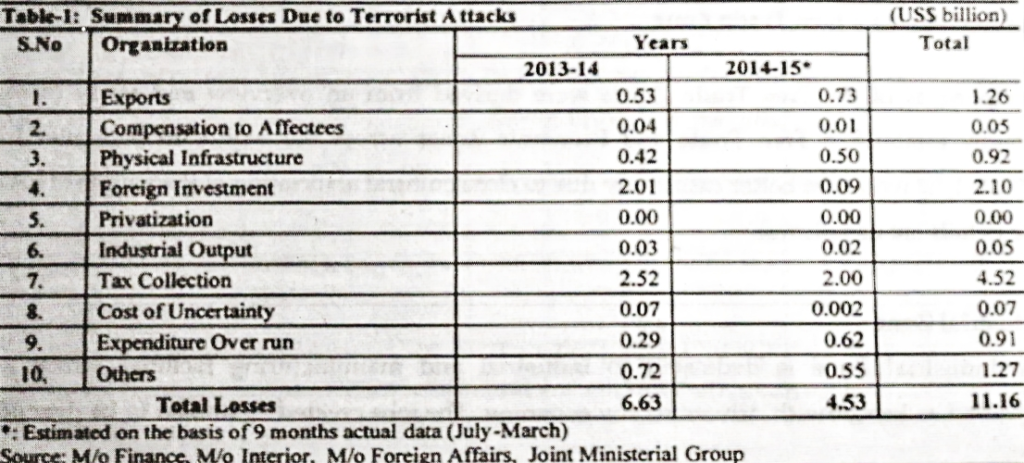
To assess the impact of the incidents of terrorism on the economy of Pakistan during the past several years, the estimates for FY 15 were prepared in consultation with all relevant Ministries/ Departments/ Provincial Governments/ Autonomous bodies etc. The Summary of year wise losses is presented in Table above.
The cumulative impact of these developments adversely affected the overall growth rate in all major sectors of the economy. Pakistan continues to pay a heavy price both in the economic and security terms due to this situation and a substantial portion of resources have been diverted to address the emerging security challenges for several years. The rise of violent extremism and increase in terrorism in Pakistan due to instability in Afghanistan not only caused serious damage to Pakistan’s economy but has also been responsible for widespread human suffering due to indiscriminate attacks against the population.16
During the last 14 years, the direct and indirect cost incurred by Pakistan due to incidents of terrorism amounted to US$ 106.98 billion (equivalent to PKR. 8.702.75 billion), details as under:17
Pakistan needs enormous resources to enhance the productive capacity of its economy by repairing damaged infrastructure and in the process creating a favorable investment climate. The security situation will be the key determinant of future flow of the investment. After adoption of National Action Plan (NAP) by the All Parties Conference (APC) duly overseen by the apex committees of the provinces there have been improvements in the recent months as a result of concerted actions by the government. However, peace and stability in Afghanistan and the region are vital for the complete revival of Pakistan’s economy and to keep stability in the system.18
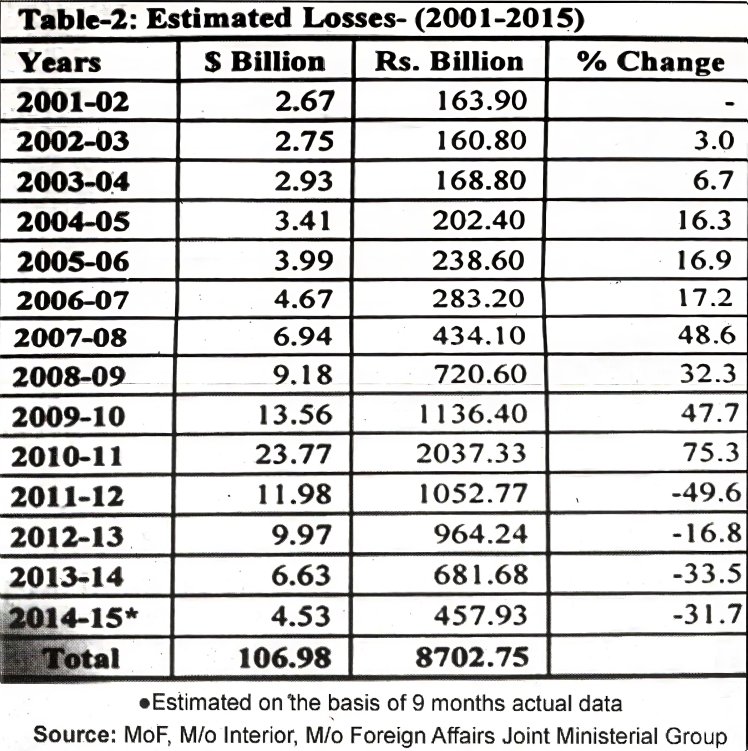
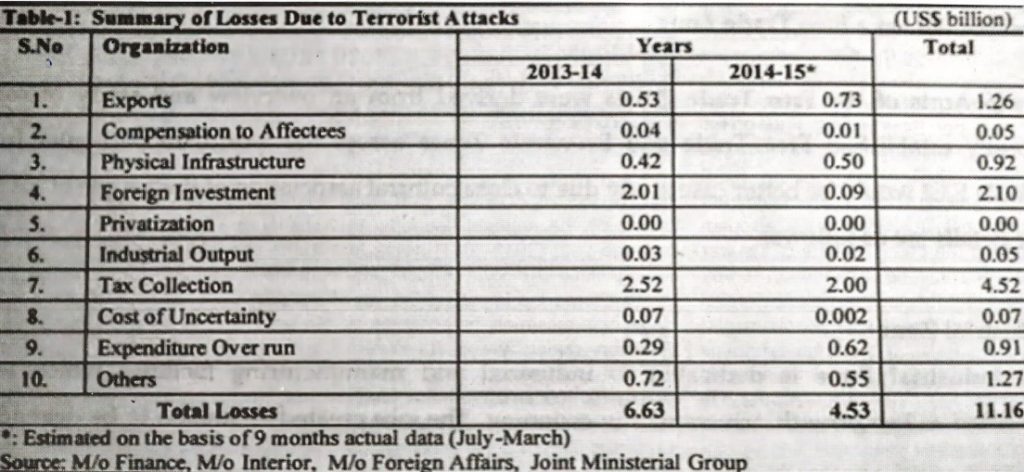
To assess the impact of the incidents of terrorism on the economy of Pakistan during the past several years, the Finance Minister constituted a committee under the chairmanship of advisor to finance with Economic advisor as Secretary / Member. Also members from Ministries of Interior, Foreign Affairs, Finance, Commerce and other relevant departments have estimated the impact of conflict in Afghanistan and the ensuing terrorism on exports, foreign investment, privatization, industrial output, tax collection etc. and updated the estimates for FY12, FY 13 and FY 14. Summary of year wise losses is presented in Table above.
The following graph depicts the number of terrorist attacks, casualties and injuries faced by Pakistan as a consequence of terrorism.
Human Loss in Terrorist violence in Pakistan (2002-2013) Year19
| Year | No. of Attacks | Killed | Injured |
| 2002 | 56 | 102 | 311 |
| 2003 | 88 | 189 | 168 |
| 2004 | 159 | 863 | 412 |
| 2005 | 254 | 216 | 571 |
| 2006 | 675 | 907 | 1,543 |
| 2007 | 1,503 | 3,448 | 5,353 |
| 2008 | 2,577 | 7,997 | 9,670 |
| 2009 | 3,816 | 12,632 | 12,815 |
| 2010 | 3,393 | 10,003 | 10,283 |
| 2011 | 2,985 | 7,107 | 6,736 |
| 2012 | 2,217 | 5,047 | 5,688 |
| 2013 | 911 | 4,160 | 3,794 |
| Total | 18,634 | 52,671 | 57,344 |
To address the situation a comprehensive and coordinated policy is required. Sultan Mehmood in his publication for Defense and Peace Economics has estimated Pakistan’s real (inflation adjusted) GDP per capita would have grown by 177 per cent during 1973 and 2008 (instead of 119 per cent) in the absence of terrorist violence. Thus the cumulative economic loss due to terrorism is around 33 percent.20
Democracy
“The history of democracy in Pakistan is a troubled one marked by ongoing tripartite power struggles among presidents, prime ministers, and army chiefs. Military regimes have ruled Pakistan for more than half of the country’s 57 years in existence, and most observers agree that Pakistan has no sustained history of effective constitutionalism or parliamentary democracy. The country has had five constitutions, the most recent being ratified in 1973 (and significantly modified several times since). From the earliest days of independence, the country’s armed forces have been perceived as “saviors of the nation” by a significant portion of the public.”21
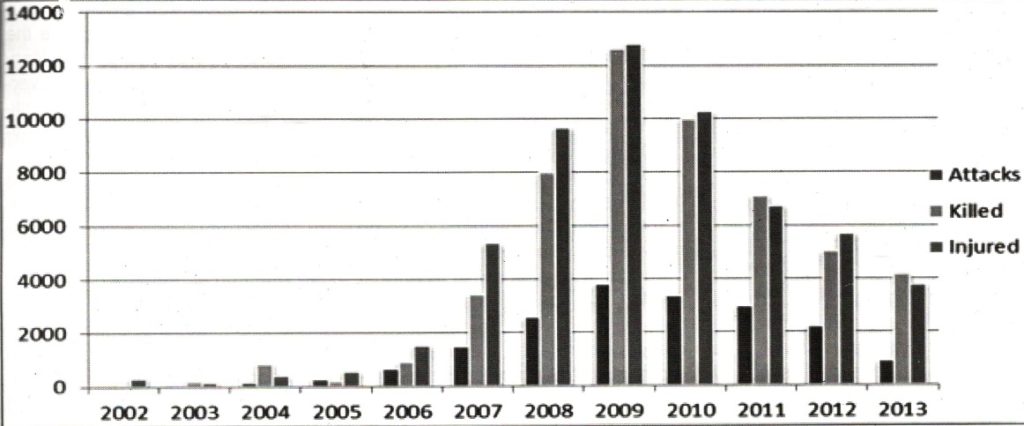
With many ups and downs in the country, politics and politicians themselves continue to be the most unstable institution. After Musharraf’s rule, the Pakistan People’s Party (PPP) won the elections by having to give a heavy price of its leader Ms Benazir Bhutto, who was assassinated in December 2007. In the elections of May 2013, the PPP was defeated by the Pakistan Muslim League – Nawaz (PML-N), where analysts claimed that the elections were relatively free and fair, other than some rigging complaints. Relations between the Sharif government and the powerful Pakistani Army have been on the loggerheads from day one, mainly due to the Sharifs being jailed and later being allowed to ‘escape’ this country after the 1999 military coup. The situation further deteriorated by 2014 when the Sharifs allowed prosecution of former President and Chief of Army Staff (COAS) Pervez Musharraf on charges of treason.
On 15 August 2014, thousands of anti-government protestors marched towards Islamabad under the banner of the Pakistan Tehreek-e-Insaaf (PTI) while Pakistan Awami Tehreek (PAT) of Allama Tahir-ul-Qadri had collaborated with PTI for gathering anti-government crowds in the past. By early September the Pakistan Army’s spokesman in a social media message asked all stake holders to show patience in the interest of the country. The military seemed to be less supportive of the government which propelled many to speculate about a possible military intervention. Though the Army Chief intervened and mediated, the protest ended with huge show of force by the opposition parties by capturing government buildings. The crowd was later dispersed by the law enforcement agencies who arrested a few and after brief interrogation were set free.
Democracy has been facing many ups and downs in the country’s history, especially when it comes under the influence of some non-visionary leaders in the name of ‘doctrine of necessity.’ In August 2014, once again Pakistan’s struggle to establish a sustainable democratic system faced major anti-governmental street protest in the capital for its revival. There was public outcry demanding the government to resign. The protestors undertook a massive blockade of the capital for several days, surrounding important government buildings and virtually paralyzing the government. The Government requested the armed forces to become a facilitator as a pre-emptive attempt to dissolve the impression of a possible military intervention in the country’s governance. Unlike in the past, the military asked the opposition and government to sit together and find a solution by themselves and warned both not to compromise the country’s security, as a result the impasse ended with a constructive dialogue and agreement on some of the opposition demands.22
As expected, the United States remained neutral to the situation and adopted a non-intervention policy in the internal problems of Pakistan, calling for continuation of the democratic process. Many Americans believe that the United States has a vital interest in US engagement with Pakistan related to regional and global terrorism, efforts to stabilize neighboring Afghanistan, nuclear non-proliferation, links between Pakistan and indigenous American terrorism, Pakistan-India tensions and conflict, democratization and human rights protection, and economic development. Perceived to be a safe haven for numerous Islamist extremist and terrorist groups, and as the world’s most rapid vertical proliferators of nuclear weapons, Pakistan presents a combination that places it at the top of many governments’ international security agendas.
Likewise, in other troubled provinces the situation has been changing. Gwadar is bustling and the parking areas at the port town’s only five star hotel, located on the Koh-e-Batil mountain that intrudes southwards deep into the Sea, is often so packed with vehicles that drivers have to wait in queues just to get in. Diners and boarders have to book days in advance to reserve a table or get a room,23 only a year back the area was almost barren with only a few visitors. The improved perception about security and safety in the area and the governmental initiatives to secure Gwadar and other CPEC projects through special arrangements are another factor behind the boom in the town.24
Karachi, the financial hub of Pakistan is still looking for a miracle to happen. The government’s intention to exert its political influence in Karachi has had counter affects depriving the city of basic facilities, the local bodies system has been almost paralyzed, the city which is still the biggest population and area wise has no practical government. Comparisons would not be practical to place Karachi with cities like Lahore or Faisalabad, but still Karachi is still producing highest revenue for Pakistan contributing more than 50 percent.25 The port city had a lucrative economy with huge industrial base but is in a fix due to security related problems and acute power shortages. Many industries are shifting either to other cities in the country or to Bangladesh.
The figures above are self-explanatory and need no clarification. It was indeed needed that the most revenue-generating and export oriented cities were facilitated with ideal business environment with appropriate funding. This had paid back once and will pay back again!
Top cities by GDP (PPP)
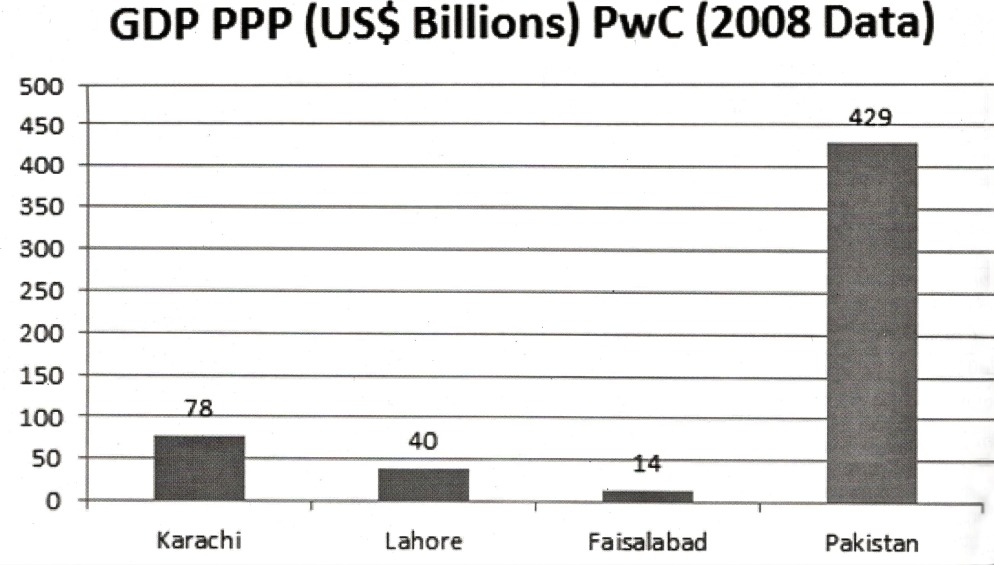
The table below lists the top cities by their PPP GDP, based on a 2013 PricewaterhouseCoopers study and is not comparable with the figures listed in the table above.
| Rank | City | Province | 2013 PPP GDP (in USD) | Population |
| 1 | Karachi | Sindh | $102 billion | 18.2 million |
| 2 | Lahore | Punjab | $40 billion | 7 million |
| 3 | Faisalabad | Punjab | $14 billion | 4.8 million |
Urbanization
By definition it is a population shift from rural to urban areas, “the gradual increase in the proportion of people living in urban areas”, and the ways in which each society adapts to the change. People generally migrate towards the urban areas for new opportunities, growth and financial gains, eventually this approach gives an indirect benefit to urban economy that leads to revenue generation for the province and onwards for the Federation.
Urban Areas as an Engine of growth
The process of urbanization effects economic and social indicators as it causes greater geographic mobility, improves fertility and life expectancy. In an economy, cities are one of the important drivers of development and help in poverty alleviation in both urban and rural areas, cities generate much of the national economic activity and provide link with rural areas between cities and across international borders (World Prospects, 2014). Further urbanization results in higher levels of literacy and education, better health facilities and greater access to social services.27
With relation to the population living in urban centers around the world at different levels of development, it seems that the world’s more urbanized regions were enjoying the highest level of per capita income in the mid of 20th century but in the late 20th century the scenario of urbanization is transformed. The projections show that urban population, over the next 30 years will be dominantly confined to the middle income countries.28
To summarize the review of this section, it depicts that world population trend has changed dramatically during 2005-10, the growth in urban areas now exceed the growth in rural population of the world. 22 percent of the population lives in US, Indonesia, Brazil, Pakistan, Nigeria, Bangladesh, Russia and Jordan. In 1990, there were 10 megacities consisting of 153 million people around the world. The number of megacities has increased to 28 – home to 453 million people in 2014. Asia itself, despite its lower level of urbanization, is home to 53 percent of the world’s urban dwellers.29
Migration pattern in large cities of Pakistan
Pakistan cities are diverse in nature. The urban topology reflects the varied political history within the region. Some cities such as Lahore and Multan served as capitals of kingdoms or were trading centers. Cities in Sindh and Punjab were present in the 18th and early 19th centuries of Pakistan.30
Conclusion
Finding resolve and discussing the prospects for a better Pakistan is even more difficult. The turbulent history of mistrust, mismanagement, radicalization, an ordeal of political unrest, a victim of terrorism and a history of economic turmoil, cannot be resolved by austere measures alone. Comprehensive efforts are required to address these long-standing problems.
Education is key to success, nations that focused on their educational system have passed and crossed over barriers of failures and unrest – Sri Lanka and Bangladesh are success stories in this regard. According to UNESCO figures Pakistan has a 58.7 percent literacy rate, and stands side by side with some of the more deprived African countries at least in the field of education. Sri Lanka has 72.3 percent and Bangladesh 62.3 percent of literacy ratings while India tops amongst its neighbors with 72.1 percent.
It is indeed a matter of grave concern that after 69 years a non-serious attitude continues towards resolving the many issues that confront Pakistan. Setting aside the government machinery, the choice of leadership is a huge problem. The problems in Pakistan are primarily aggravated due to lack of understanding and resolve. No government machinery would ever be successful until its policies are receptive by the masses. Governance is another problem that has to be addressed. Dr. Maleeha Lodhi, Pakistan’s Ambassador to the United States, stated as follows,
Effective governance is what makes the difference between successful states and struggling states. Improving the quality of governance is therefore central to the efforts to move Pakistan beyond the ‘crisis state’.31
Pakistan needs extensive foreign assistance to overcome its numerous development problems and reinforce its ability to confront internal and regional threats from jihadists. There is lack of understanding, except for few within the donor agencies like US Agency for International Development (USAID, United Kingdom Department for International Development (DFID), Department for Foreign Affairs, Trade and Development (DFADT, former Canadian International Development Agency, CIDA), the European Union (EU), Swiss Development Cooperation (SDC), Japan International Cooperation Agency (JICA), the World Bank (WB), and others to use that aid from a temporary fix into a program of long-term therapy and rehabilitation.32 This assistance may be used to start training programs for the judiciary and civil services, to enhance the policy-making infrastructure, to develop institutions for a comprehensive accountability of politicians and to bring intelligentsia on board for contributing to a pragmatic and problem-solving approach within the country.
The leadership crisis in Pakistan has several dimensions, it goes beyond the political dome. ‘A small elite (as few as a thousand people) has long used its influences in a self-serving way, starving the government of revenue, undermining the rule of law and caring little as how most of the population would probably live.’33 To add to problems there was also a long standing power struggle amongst the civilian bureaucracy and the military leadership. In Pakistan it’s a common perception that ‘We’re not a poor country. We’re a poorly managed country.’
During General Musharraf’s rule it was mandatory for elected parliamentarians to have at least Graduate’s Degree although it must be said that after him many Degrees turned out to be fakes. Except for a few, the elected leadership lacks political understanding of disputes and how to resolve them. The mental capability and educational profile of such parliamentarians negates the aspiration and intention of the masses for electing a true leadership. The possible outcome is therefore a fragile political leadership and political parties that upset any resolve that the government may have to push through reforms for revenue generation and social sector development for the relief of the masses.
Corruption leads to nepotism while supporting and patronizing the corrupts’ kith and kin, some top government officials protect their own interests at the expense of the country; a possible outcome of this is that important legislations are put behind shelves and high priority problems such as energy, education, etc. are allowed to linger on and on for years without resolution. If incompetence and corruption of the ruling elite were not enough to derail the economy, Pakistan’s sustained bout with terrorism has done the rest.
End Notes
1 Lawrence Ziring, ‘Pakistan in the Twentieth Century, A political history,’ Oxford, 2007 p. 605
2 According to Muhammad Ali Jinnah, the founder of Pakistan, Hindus and Muslim were two separate entities and they could happily live if they would be divided in their respective states of their majority or where they are concentrated. Later on the theory was modified and agreed upon by Hindus majority as well and two nations of Pakistan and India came into being on 14 and 15 August 1947 respectively.
3 Daily Nawai Waqt, 15 November 2008, Rawalpindi
4 Dr. Qadar Baksh Baloch, ‘Pakistan’s Trade Imbalance & Melting Down of Economy,’ The Dialogue, Vol. 3, No. 2, 2008, p. 149
5 The News, 25 July 2008, Islamabad
6 Mansoor Ahmad, “Survey Highlights Flaws in Agriculture system,” The News, 11 June 2008, also refer Pakistan Economic Survey 2007-2008
7 Marshall- Lerner were the pioneers of the elasticity approach to the balance of payment
8 26 October 2016, ‘Trade deficit shows Pakistan net loser in Free Trade Agreements,’ www.pakrevenue.com, http://www.pkrevenue.com/exclusive/trade-deficit-shows-pakistan-net-loser-in-free-trade-agreements/
9 12 April 2016, Trade deficit balloons by over 20pc in March 2016, www.pakrevenue.com
10 Data released by Pakistan Bureau of Statistics (PBS), www.pakrevenue.com
11 11 February 2016, ‘Pakistan exports fall by 14.37 percent in seven months; trade deficit widens,’ www.pakrevenue.com
12 “Growth and Investment,” Pakistan Economic Survey, 2014, Finance Division, Government of Pakistan, p. 18
13 Sheikh Fahad, “Economic Terrorism & Its Impact on Pakistan,” Economic Review, Strategem, http://www.stratagem.pk/economic-review/economic-terrorism-its-impact-on-pakistan/
14 Ibid.
15 Ibid.
16 Pakistan Economic Survey 2014-2015, ANNEX-IV, P. 279
17 Op.cit. P. 280
18 Ibid.
19 Pakistan Institute for Peace Studies (PIPS) Annual Security Reports 2008-2012; South Asian Terrorism Portal (www.satp.org) ; Data received from the National Crisis Management Cell (NCMC), Ministry of Interior, Pakistan.
20 http://www.dawn.com/news/1158474/33-stronger-a-pakistan-without-terr…
21 K. Alan Kronstadt, “Pakistan’s Domestic Political Developments, CRS report for Congress, Foreign Affairs, Defense and Trade Division, 19 September 2005, CRS-7
22 K. Alan Kronstadt, Op.cit. p. 392
23 Maqbool Ahmad, ‘Worrying development – Filed notes on war and peace in Baluchistan,’ Herald, April 2016,p. 48
24 Ibid. 49
25 Please refer to Wikipedia citations of the Federal Board of Revenue (FBR), stating the FBR claims that Karachi is referred as the financial capital of Pakistan; it accounts for most of Pakistan’s revenue generation. It generates about half of the total collections of the Federal Board of Revenue, out of which, approximately half are customs duty and sales tax on imports. Karachi produces about 30 percent of value added in large scale manufacturing] and 20percent of the GDP of Pakistan. In February 2007, the World Bank identified Karachi as the most business-friendly city in Pakistan. In 2010, research by the global human resources company Mercer found Karachi to be the most inexpensive city in the world. https://en.wikipedia.org/wiki/Economy_of_Karachi
26 https://en.wikipedia.org/wiki/List_of_Pakistani_provinces_by_gross_domestic_product
27 ‘City Dynamics in Pakistan,’ 2015, Applied Economics Research Centre, University of Karachi, AERC, Urbanization – World’s Perspective, P.7
28 P.7
29 P.8
30 Country Study (2002), published by Federal Research division, library of congress, Washington D.C., 20540 – 52207, p.148
31 Maleeha Lodhi, ‘Concluding Note’, in Lodhi (ed.), “Pakistan: Beyond the ‘Crisis State’” (New York: Columbia University Press)
32 GES Brief: Ideas 1/2012, A Report on the Deliberations of the Global Economic Symposium (GES) Working Group on ‘State Building in Pakistan’ Improving Pakistan’s Political Economy: What Foreign Assistance Should Contribute’
33 Stephen Philip Cohen, The Idea of Pakistan (Washington, DC: Brookings Institution Press, 2005)


